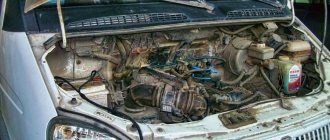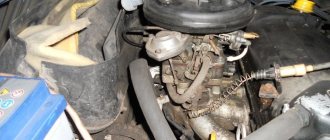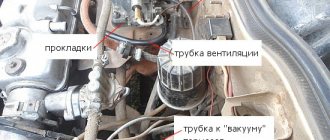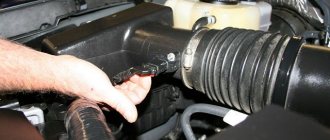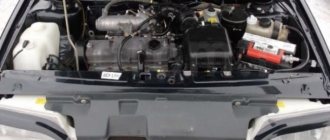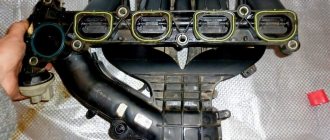A fairly common malfunction is unstable operation of the engine in idle mode, during so-called throttle changes, and also when the speed while driving is low. In this case, the driver begins to feel increased vibrations on the steering wheel, gearshift lever and body.
In other words, the car shakes a little because the engine is shaking. In fact, the concept of “troubling the engine” should be understood that one or more cylinders do not work, that is, the fuel-air mixture in them does not ignite, does not ignite in a timely manner, or the combustion of the charge does not occur in full.
Moreover, if the speed is increased to XX or when the engine is under load (while driving), the operation of the power unit is normalized, the engine twitching disappears, the engine runs smoothly and stably. Next, we will look at why the engine stalls at idle and what the driver should do in such a situation.
Troubleshooting
The driver's term "troit" means that interruptions are heard in one or more cylinders while the internal combustion engine is running. To fully verify this, you need to stand near the exhaust pipe. The changed sound of the engine is clearly visible here. The phenomenon is called “missing,” but the definition of “troit” arose from the functionality of four-cylinder engines. If one fails, only three remain in operation, creating a triple sound.
With this malfunction, the engine does not pull, especially when accelerating. Modern vehicles have three six-, eight-, and twelve-cylinder power units. In this case it is observed:
- body vibration;
- unstable low crankshaft speeds;
- increased fuel consumption;
- loss of power.
To accurately determine the cause of the problem, you need to pay attention to many signs: conditions when the engine does not pull, the moment when the sound becomes stronger - after warming up or when cold, at idle or under load, at low or high speeds, uniform movement, acceleration or coasting. Any little thing, sometimes meaningless, can suggest the right decision.
Tips and tricks
Please note that in order to check the functionality of the ignition system, in some cases it is recommended to check the spark plugs for a spark
It is important to understand that if you simply unscrew the spark plug from the engine, the presence of a noticeable spark on the electrodes is not always a sign of complete serviceability
The fact is that ignition coils on injection engines can cause a weak spark, or even the spark strength can be quite normal. However, after heating the coil, the spark power decreases, malfunctions occur, and as a result, the fuel-air mixture does not ignite or ignites intermittently (misfire).
At the same time, checking the coils cannot be carried out by diagnostics or various tests, since in many cases the problem can be “floating”, and in the case of the test the readings will be normal. Finally, we note that practical operation identifies problems and malfunctions in the operation of ignition coils as one of the common causes of engine tripping after warming up.
Possible reasons
Uneven engine operation can be observed as a result of the following general malfunctions:
- the most common reason is failure of spark plugs;
- incorrect ignition timing adjustment;
- breakdown of high-voltage wires;
- air filter clogged;
- use of spark plugs for purposes other than their intended purpose;
- carburetor not adjusted;
- capacitor failure;
- burnout of pistons and valves;
- wear, breakage, deformation of piston rings;
- violation of operating valve timing;
- high wear on valve rockers;
- air leakage through the vacuum brake booster or intake manifold;
- leaky membrane of the vacuum ignition timing regulator;
- wear of the distributor shaft or rotary plate bearing;
- destruction, breakdown, hardening, wear of valve stem seals;
- breakdown or burnout of the cylinder head gasket.
It is necessary to begin repairs when a non-functioning cylinder is identified. Finding it is not particularly difficult. With the engine running, the tips of the high-voltage wires are removed from the spark plugs one by one. On the working cylinder, after removal, the sound becomes different. If, after removing the tip, the sound remains the same, this cylinder does not work.
Suction of foreign air
If the engine shakes a lot, if the idle speed is very unstable, it is possible that the reason is due to the leakage of foreign air. In this case, the mixture becomes excessively lean, which causes tripping due to misfires. It is recommended to check the intake manifold for leaks.
You should visually assess the condition of the gaskets and hoses in the vacuum system. It is also necessary to check the O-rings on the injectors
Particular attention should be paid to the vacuum brake booster and its valve. It is generally not difficult to detect air leaks - for this you can use a regular cigarette or carburetor cleaning fluid in cans
If there is an air leak, the smoke from the cigarette will go into the leak area. If you spray the area where there may be a leak with liquid, the speed will stabilize and increase. If the system is completely sealed, but the VAZ-2114 engine still trims at idle, then the reason is deeper. We'll talk about this later.
Analyzing and fixing the problem
If the ignition is set incorrectly, the engine jerks and slams. It must be listened to in low operating mode. With a strong mode, the work is leveled out, and skipping beats is not heard. Early ignition manifests itself in jerks when cranked by the starter.
A damaged hose, valve, or diaphragm of the vacuum brake booster allows air to leak from the atmosphere. Excess air leans the fuel mixture. The spark plug gets wet and cannot create a normal spark to ignite the mixture. The fault can only be identified experimentally.
When a cold engine revs heavily, this indicates a problem spark plug. Its appearance speaks volumes to an experienced mechanic. The normal color of the insulator is light or slightly brownish. Oil traces and carbon deposits on the insulator indicate that the spark plug is being filled with an over-enriched mixture; there is no normal sparking. The spark plug body must be free of cracks and chips. It must be checked for spark quality. If sparking is weak, the spark plug must be replaced.
A breakdown of high-voltage wires and a capacitor occurs when the engine is not warmed up. This malfunction can be observed in the dark. Surface sparkling is noticeable on the wires and capacitor above. The resistance during measurements should not exceed 20 kOhm.
Burnout of pistons and valves is determined by measuring engine compression. The engine shakes constantly: cold, hot, loaded, at idle.
Common problems on all engines at idle
As the old saying goes, a motor won't run if there's nothing to ignite, or nothing to ignite. For gasoline engines with quantitative control of the mode, the idle conditions are the most severe. The throttle valve is closed.
The volume of air entering the cylinder is minimal, and so is the pressure - just enough fuel mixture is supplied to allow the engine to rotate.
The oscillogram of the pressure in the cylinder, even at slightly increased speeds, gives us a pressure peak slightly above 5 bar. And this, mind you, is a serviceable engine, whose compression when hot is 13 bar. Now imagine what the pressure will be when it’s cold, when the pressure loss through the piston rings is greater. Therefore, since ancient times, almost the first thing people look at when a car stalls at idle is the condition of the engine. Measuring compression, even with a crude mechanical pressure gauge, accurately determines how worn the cylinder-piston group or valves are. In highly accelerated engines, wear is also added to by the possibility of errors when setting the marks of the gas distribution mechanism. Where the GAZ-69 works quietly when the camshaft gear is shifted by a tooth, a more modern engine is no longer able to hold idle.
Excessive pressure losses in a worn-out engine during the compression stroke can only be compensated by increasing the air supply. You have to maintain the speed with the gas pedal, but starting the engine will be a whole ritual, since at starting speed the peak compression pressure is even lower than at idle.
For a diesel engine, compression is even more important. By heating the air, which is compressed in the cylinder, the fuel injected by the injector is ignited. At the same time, the regulation of the regime in diesel engines is qualitative, not quantitative: as much air enters the cylinder as it can draw in, only the volume of injected fuel changes. But due to the fact that at idle the compression stroke time is the greatest, with loss of tightness (wear of rings, burnout of valves, losses through the cylinder head gasket), the highest loss of compression pressure will be at idle, and a diesel engine operating normally at high speeds, when released The gas pedal may also start to stall.
Finally
In conclusion, we will give advice from experienced drivers. Even if the car suddenly starts idling, you should not panic or get upset. There is always a decent way out. The machine can move at low speed in idle mode to the nearest service station. You can get expert advice by phone or iPhone. Replace a faulty spark plug by purchasing one at the nearest gas station. If you are afraid of more severe damage, a tow truck will help deliver the vehicle to the repair site.
Before you start looking for the causes of this problem and finding out what it can lead to, you need to understand what it means to trip an engine. Otherwise, this phenomenon is called “missing” and means interruptions in the operation of one or more cylinders of an internal combustion engine. The term “troit” owes its appearance to a four-cylinder internal combustion engine. If one of the cylinders fails, only three work. As a result, the engine does not pull, this becomes especially noticeable during acceleration. Currently, a six- and even twelve-cylinder power unit can “triple”, although this is not entirely true from the point of view of the Russian language. As a visual aid, you can find a video of an engine throttling on the Internet, and there you can also find a video about what to do in such situations.
Features of modern engines
Today's power units differ from engines of the last century in that they are stuffed with a large number of electronics. If previously everything was controlled mechanically, now the operation of the engine is completely controlled by a computer. It is this engine control system, consisting of a control unit and auxiliary sensors, that is responsible for the fact that we periodically have to turn to a car service center for help.
After all, as it was before: you cleaned the carburetor, tuned it and you drive happy. This trick won't work with modern engines. From time to time you need to adjust the sensors, clean them, and ultimately change the engine firmware. Firmware is a kind of program, in strict compliance with which the engine operates. In short, the introduction of electronics into motors made them more vulnerable.
Why does the engine troit?
At first glance, the causes of the problem lay on the surface: either there is nothing to burn in the cylinder, or there is nothing to ignite the working mixture. However, this is only at first glance. In fact, it can be very difficult to understand why the engine suddenly began to stall during startup or acceleration, and searching for the “root of evil” can take more than one day, especially in garage conditions.
It is important to pay attention under what conditions the engine does not pull when it starts to rev more strongly: when cold or after warming up, when driving under load or at idle, at low or high speeds, during acceleration or during uniform movement. Any little thing, often seemingly irrelevant, can be a clue.
So, why does the engine stall? The main reasons causing this malfunction are as follows:
- incorrect ignition timing;
- suction of atmospheric air in the vacuum brake booster;
- faulty spark plugs (the most common cause);
- broken high-voltage wires;
- faulty capacitor;
- air leak in the intake manifold;
- burnout of valves or pistons;
- broken, worn or deformed piston rings;
- violation of valve timing;
- severely worn valve rockers;
- burnout or breakdown of the cylinder head gasket;
- worn valve stem seals (hardened, pierced or completely destroyed);
- incorrectly adjusted carburetor;
- worn distributor-distributor shaft or rotary plate bearing;
- clogged air filter;
- loss of tightness due to deformation or wear of the membrane of the vacuum ignition timing regulator;
- the use of spark plugs that are not suitable in their parameters for this engine.
Suction of foreign air
If the engine shakes a lot, if the idle speed is very unstable, it is possible that the reason is due to the leakage of foreign air. In this case, the mixture becomes excessively lean, which causes tripping due to misfires. It is recommended to check the intake manifold for leaks. You should visually assess the condition of the gaskets and hoses in the vacuum system. It is also necessary to check the O-rings on the injectors
Particular attention should be paid to the vacuum brake booster and its valve. It is generally not difficult to detect air leaks - for this you can use a regular cigarette or carburetor cleaning liquid in cans. If there is an air leak, the smoke from the cigarette will go into the leak area
If you spray the area where there may be a leak with liquid, the speed will stabilize and increase. If the system is completely sealed, but the VAZ-2114 engine still trims at idle, then the reason is deeper. We'll talk about this later.
Finding a broken cylinder
This task is not difficult. The only thing that needs to be done is to disconnect the tips of the high-voltage wires from the spark plugs one by one with the engine running. If you disconnect the working cylinder in this way, the sound of the motor will change, but if after disconnecting the tip the sound remains the same, it means that a non-working cylinder has been found.
When disconnecting high-voltage wires, you must be careful because the risk of electric shock is very high. This is not fatal, of course, but very unpleasant. First, you need to place a dielectric material under your feet, such as a dry board or rubber mat. Secondly, you need to disconnect it by holding the wire itself, and not the cap. Thirdly, you must not touch the car body during the procedure.
A few words about tripling
Troubleshooting of the average motor is a completely normal phenomenon, but only when it occurs one-time and infrequently. If the engine misfires systematically or at certain operating modes, then it is worth thinking about the correct functioning of some components of the machine. Frequently, tripling is caused by disturbances in the operation of two car systems:
- Ignition. In this case, it does not work correctly, sparking is disrupted and the cylinders lose synchronization of operation. As a result, the engine begins to vibrate intensely and loses power and dynamics;
- Fuel supply. If there are problems in this system, tripping occurs due to a lack of fuel mixture, which also leads to asynchronous operation of the cylinders. The result is the same vibrations and loss of power.
A detailed analysis of the reasons for engine tripping
Although a tripping motor exhibits the same symptoms every time, it is much easier to solve the problem if you know the specific causes of this phenomenon. The main reasons causing the failure of one or more engine cylinders were listed above. Because of them, the engine does not pull at high speeds, it trots strongly at low speeds, during startup or acceleration, after warming up or when cold. Let's take a closer look at them.
Incorrect ignition timing
If the engine stalls for this reason, then a kind of clapping sound is heard, during which the engine jumps. To accurately determine this malfunction, you need to listen to the engine at low speeds, since at high speeds its operation is leveled out, and skipping cycles becomes unnoticeable. As a rule, the above signs indicate excessively early ignition. This is confirmed by the jerks that the engine makes when cranked by the starter.
Intake of atmospheric air in the vacuum brake booster
If the car has a vacuum brake booster, air leaks occur when the diaphragm, hose or valve is damaged. Excess air appears in the system, which mixes with the working mixture, depleting it. As a result, the mixture in the cylinder may not always ignite. The spark plug, in turn, gets wet and cannot form a normal spark that can ignite the air-fuel mixture. This malfunction is quite difficult to identify, since there is no special equipment capable of determining exactly where the seal of the vacuum booster system is broken.
Faulty spark plug
An accompanying symptom that confirms the hypothesis that the cause is the spark plug is the fact that a cold engine trots more strongly. After warming up, the problem often disappears or becomes less pronounced.
First of all, you should pay attention to the color of the central electrode insulator. Determining a normally working spark plug is not difficult. A normal insulator is light or slightly brownish. If the color of the insulator is different from normal, then you need to find out why. Traces of oil or carbon deposits on the insulator indicate that an over-enriched mixture is entering the cylinder, which floods the spark plug, or it is “filled” with oil. As a result, normal sparking is disrupted.
The reasons for this may be different:
- the engine idles a lot when warming up;
- the check valve of the power supply system is faulty;
- low compression in the cylinder;
- impaired valve timing;
- malfunctions in the operation of injectors;
- failure of the oxygen sensor.
After the insulator, you should inspect the spark plug body. It must be intact, without chips or cracks. Particular attention should be paid to the presence or absence of vertical black stripes and black dots. If they are, the spark plug is broken and needs to be replaced.
Finally, the quality of sparking is checked. Moreover, simply connecting the side electrode to ground is not enough, in this way you can only check the performance of the spark plug. To understand how well the spark plug works, you need to hold it at a distance of one and a half to two centimeters from the ground and turn on the starter. If a large bright blue spark forms between the electrodes, the spark plug is working normally. A weak spark or its complete absence indicates that the ignition coil or switch is faulty, or the high-voltage wires have increased resistance.
BB wires
If the engine stalls at idle, the problem may be related to the operation of the ignition system. The culprit is the armored wires, which most often fail. If the wire is damaged, then the spark will break through and, naturally, there will be no spark at the spark plug. The fuel mixture in the cylinder will not ignite. It is best to check the wires with a multimeter.
Among the malfunctions of the wires, one can identify problems with the contacts at the points of connection with the spark plugs or with the coil. Also, the conductor may have various damages. If the insulation is destroyed, this will be accompanied by breakdowns and current leakage. In addition, increased wire resistance is also considered a malfunction. This also negatively affects sparking and the operation of the ignition system.
What to do first if the engine seizes up
Summarizing all of the above, we can draw up small instructions on what to do if symptoms of a throbbing engine appear.
If the engine shakes more when starting or when cold, you need to start your search by checking the spark plugs and high-voltage wires. If the problem becomes more pronounced after warming up or under load, it is better to first check the condition of the air filter.
It is better to check other possible reasons as the work becomes more complex. » alt=»»>
If the engine is misfiring, that is, not all cylinders are working, you should immediately pay attention to this problem, carry out diagnostics and eliminate the causes of this problem. Otherwise, you will have to face even more noticeable challenges that will turn out to be a real problem in the future. The expression “engine is throttling” is no longer very relevant, because it means that three out of four cylinders are working. In fact, not all cars today have four cylinders, but the term is also used for V6 or V8 units.
The real problem with modern engines is that the shutdown of one or two cylinders is not always felt as a jolt in the cabin and on the steering wheel. For example, V6 engines often have a system for forced shutdown of two cylinders when there is no load. This helps save fuel and reduces wear on the power unit. However, the problem of the cylinders suddenly stopping is serious and can cause some problems.
Wire diagnostics
If the engine is adjusting on the canvas, then experts recommend making sure that the wires are in good condition.
One of the easiest diagnostic methods is to use a working wire. It is installed on each of the cylinders. If after these steps the engine begins to operate stably, then it is worth replacing the entire kit.
To find the breakdown, you need to wait until it gets dark outside. In the dark, open the hood and start the engine. The breakdown, if there is one, will be clearly visible - a spark will strike at the place of the breakdown.
If you have an additional insulated cord, you can also check the serviceability of the high-voltage wires. It is necessary to strip the ends, and then one end of the wire is shorted to ground. The other end is driven along the surface of the cord - special attention should be paid to bends, caps, and joints. If there is a breakdown, then a spark forms between it and the wire.
Finally, you can check the resistance using a multimeter. The device is switched to resistance testing mode. Then the multimeter contacts are connected to the two ends of the wire. If the cord is working properly, then its resistance will be in the range of 3.5 kOhm to 10 kOhm. If the resistance threshold is higher, then it is better to replace the wires.
How can you tell if the engine is really stalling?
The driver’s first task is to determine that the problem is due precisely to the fact that the power unit is tripping, that is, one of the cylinders is not working. To do this, you need to use the built-in diagnostic tools if you own a modern and technologically advanced car. Otherwise, you can remove the high-voltage wires from each spark plug one by one and observe the engine's reaction.
It is very easy to detect a non-working cylinder - if when removing and putting the wire on the spark plug there is no reaction from the power unit, this cylinder is not working. Usually, when a previously disconnected cylinder is connected, the speed rises slightly and the power unit begins to operate more smoothly. In general, the indicators that the engine has started to stall are as follows:
- there is a certain rattling sound in the cabin at idle, which practically disappears when you press the gas pedal;
- The car takes longer to warm up if the ambient temperature is low;
- the engine makes unusual sounds, the operation of the unit is uneven, a loss of tact is felt;
- the engine lost about 30% of its power, which immediately affected the car’s traction;
- Fuel consumption has increased for no particular reason - the increase may be 10-15 percent;
- The on-board diagnostic system indicates the need to check the power unit at a service station.
Transmission
There is only one gearbox - 5-speed manual. There are many complaints from owners about the clutch, which begins to slip already after a mileage of 20–40 thousand km. After opening it, it is discovered that the disk is not worn out, but after replacing it, no such problems arise. A new clutch kit will cost 4-6 thousand rubles, and replacing it will require about 3 thousand rubles.
Many also note the appearance of a hum in the box when releasing the gas in 2nd and 3rd gears with a mileage of more than 20 thousand km. After replacing the input shaft bearing, the noise goes away. In winter, due to the jamming of the box breather valve, the seals can be squeezed out. The speed sensor is a real consumable, failing after 10 - 20 thousand km (1000 rubles).
Negative reviews are also directed at the suspension, which begins to creak after a mileage of more than 20 thousand km, more often in winter. In addition, with the advent of frost, knocking noises appear, which can often be eliminated by tightening the suspension elements. Shock absorbers can leak after a mileage of more than 20 - 30 thousand km, by which time the anti-roll bar struts begin to knock.
Problems with ABS are also quite common. The reason is the chips that are not properly clicked, the poor quality of the brake fluid poured during assembly, and less often, the ABS sensors themselves. Original brake pads are very hard, which leads to rapid wear of the brake disc and excessively early activation of ABS in critical situations.
In winter, the power steering pump often begins to “growl”, the reason is in the fluid, replacing which solves the problem. Steering rods begin to tap already after a mileage of 10 - 20 thousand km (1-2 thousand rubles).
The main causes of the problem if the engine starts to trip
Many drivers believe that the engine only idles at idle, and while driving the non-working cylinder is connected. In fact, this is not true. If the power unit idles at idle, it means that the cylinder also does not work when driving. This can result in excessive unused gasoline entering the crankcase, diluting the oil to a too thin state and losing its performance properties.
If the power unit in your car starts to fluctuate at idle only when cold, we recommend changing the oil. Its viscosity may be too high for the unit. If, even when the car is warm, the non-working cylinder does not turn on, then it is necessary to pay special attention to the following possible problems in the power unit system:
- high-voltage wires and spark plugs may be faulty - this is the simplest possible problem;
- perhaps the cause of the problems is a completely clogged injector, which does not spray fuel, but pours it like a river;
- on old carburetor cars, the car could stall due to a malfunction of the idle speed sensor, oddly enough;
- also, on any gasoline and diesel car, the intake or exhaust valve may break;
- Loss of compression in one of the cylinders is also often the reason why the unit begins to fail.
Wires and spark plugs can be replaced yourself. Even if they are not the reason, you will completely remove this issue and be able to pay attention to more specific possible options for the problem. Checking the fuel system and cleaning the injector will also not harm your car, but this process should be performed by specialists.
Also the valve system must be checked. Sometimes the valves get stuck and won't open to accept fuel, and in some cases the valves haven't been adjusted for too long, the clearances are off, and the valve can't do its job. But these are not the most expensive problems in this case.
Fuel system
Continuing the topic of modern injection engines, it should be noted the problems associated with clogged injectors. In this case, the injection of the fuel mixture is uneven, and as a result the engine trims at idle.
Experts recommend cleaning the fuel system more often, cleaning injectors, and refueling with high-quality fuel. Sometimes it happens that the problem appears after refueling with unknown gasoline at unfamiliar gas stations.
Another reason is fuel pressure. It can be either insufficient or too much. If a pressure regulator is installed in the fuel rail, then the ideal indicators are approximately 2.5 bar at idle. If the regulator is in the tank, then the pressure should be maintained at 3.8-4.0 bar. If the pressure does not match, then it adjusts the Kalina engine at idle. This phenomenon is typical not only for Kalina, but also for Priora.
Loss of compression and lack of operation of one of the cylinders - overhaul
If all the verification stages described above did not give the desired results, you will have to resort to the last possible problem. Check the compression in the cylinders. This can be done at a service station; the procedure will not take too much time.
Lost compression in one of the cylinders will cause it to not work, so the engine will require major overhaul. After disassembling the power unit, it will be clear what kind of repair the engine needs, but the most common repair procedures are as follows:
- replacing piston group elements with new parts;
- boring the cylinder block for a larger piston diameter;
- removing signs of increased metal wear in the engine;
- rendering a verdict on replacing the power unit.
In the first three cases, you can get away with a relatively small amount of money. But some owners of modern cars will find, to their dismay, that major engine repairs for their vehicle are unacceptable. In this case, you will have to look for a contract or new engine to replace the old one.
This will cause significant costs for car repairs. Interestingly, many car owners bring the engine to the point of needing major repairs with their own hands. It is simply too late to notice that the engine is running rough and requires minor repairs. In this case, further operation will require repairs.
See more information about the reasons why the engine troits in the following video:
We go to the service station for service
Using low-quality fuel can also lead to serious engine damage. This may not only be problems with the fuel filter, but also general contamination of the injection system.
It should be said that such a breakdown can only be determined after computer diagnostics. Such diagnostics will allow you to identify existing problems with the injectors, after which it is necessary to replace failed spare parts under service conditions.
We would not recommend changing the injectors yourself. This kind of work is complex and can only be done by experienced workshop technicians on modern cars.
Control block
In some cases, the reason why the engine does not pick up speed and there are operational problems is the failure of the control unit. The engine's computer brains send the engine the wrong signals, causing the engine to shake and the engine to run rough.
Such a breakdown can also be determined only after computer diagnostics. Depending on the nature of the problem, it is necessary to either reprogram the control unit or replace it. In the latter case, the cost of repair work can be quite high, since such engine brains are expensive.
Ignition
Retarded ignition is also a common reason why an engine runs rough. If the engine does not pick up speed, there is a pronounced shudder, the cause of the problem in this case may be late ignition. The fuel mixture entering the cylinders is simply not completely burned and continues to burn in the exhaust manifold.
As a result, the power unit operates unevenly, noticeable detonations appear, the engine runs intermittently, and the existing engine control unit begins to forcibly reduce engine speed.
Let's sum it up
If your car's engine starts to stall, pay attention to this process in advance. This way you can get rid of problems with the power unit and prevent possible expensive repairs. Such attention to the operation of the main components of the car is a real necessity today, because engine overhaul on some cars is completely impossible.
Always pay attention to how the power unit of your car works, because this is the most expensive component of the car, which is difficult and expensive to repair. Have you ever encountered a problem where the engine misfires and the cause of this phenomenon is unknown?
Sensors
One of the common reasons why the VAZ-2115 engine adjusts at idle is sensors. The main culprit for unstable operation is the mass air flow sensor or mass air flow sensor. In addition, you should definitely check the throttle position control element or TPS and the idle speed control. DPKV can also create problems (affects the operation of the crankshaft).
Along with problems associated with sensors, various malfunctions can also be identified that are directly related to the ECU itself. There are cases when the Priora engine simply slightly adjusts at idle, and diagnostics using electronic priors reveals errors that cannot be eliminated.
Sometimes the engine misfires due to ECU tuning that is popular today. After flashing, which is not recommended by the manufacturer, characteristic symptoms of tripling may appear.
Learning to deal with the problem
In a situation where the injector is tripping, there is no need to immediately contact professionals at a service station. This is due to the fact that in the vast majority of cases this problem can be solved simply, and at service stations they will charge a considerable amount for its solution, including general diagnostics of the car and the search for the cause of the malfunction as part of the repair. Why pay for what are essentially completely unnecessary procedures?
Having decided to deal with the problem of tripping yourself, you need to act competently and carefully, without provoking new breakdowns. Often the following is enough to identify and fix a problem:
- First of all, we check the spark plugs. To do this, remove each of them one by one, attach them to the “ground” (engine body) and turn the starter. If the spark is bright and appears uninterrupted, everything is in order with the candle. Otherwise, you need to clean it, or better yet, completely replace the part with a new one;
- Let's say that the implementation of the actions described above did not produce results. Next, we proceed to inspect the main components, the malfunction of which could cause the engine to trip. The latter include:
- caps and high-voltage wires of spark plugs (we inspect them for external defects and “ring” them with a multimeter);
- air and fuel filters (assessment for clogging, cleaning and replacement if necessary);
- fuel pump and its fuel lines (analysis of stability and correct operation, if necessary, disassembly, cleaning, complete or partial replacement);
- engine (we check the compression, if it is significantly lower than normal, we carry out a more detailed check of the engine components).
- If even after the measures described above there is no result, you will have to act more globally. More precisely, it is necessary to check all components of the ignition system, disassemble and clean the injector, and if there are problems with the engine, repair it. Perhaps, it is at this stage that you can already contact a service station, since not all motorists are able to carry out the required actions themselves. But if specifically you are a jack of all trades, then it is quite possible to fix it yourself.
Let us repeat, in the process of all repair and diagnostic work you need to act competently and carefully. Otherwise, careless actions can not only fail to achieve the desired effect, but also provoke more serious damage.
We hope that the material presented today has fully made it clear to all readers of our resource the essence of triple injection engines. Good luck in maintaining and operating your car!

